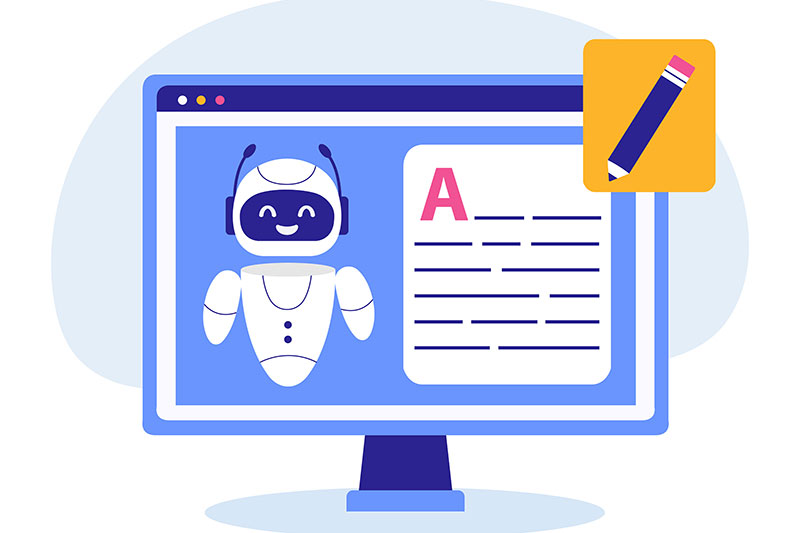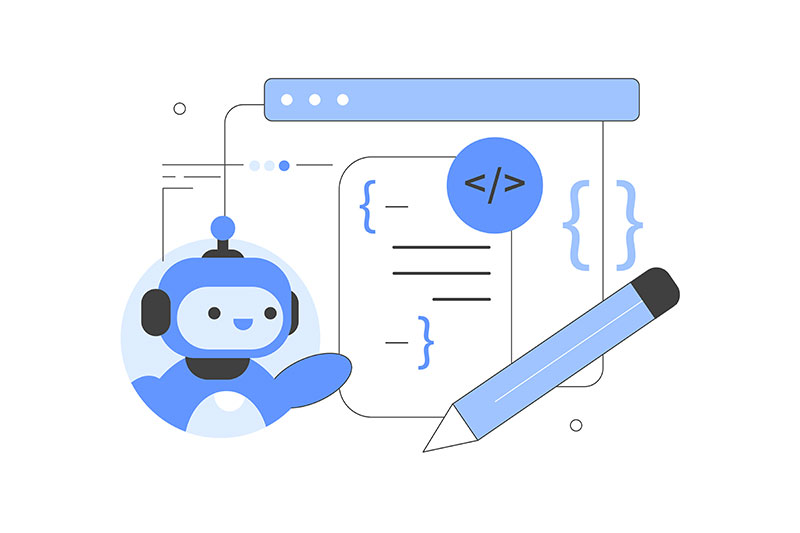Can AI Writing Be Flagged as Plagiarism? What Educators and Students Should Know
The development of technologies in the field of text generation has significantly affected the educational process, with AI writing being a real success among students.
It is no secret that most of them actively use LLM to create written works. But can AI writing be considered plagiarism?
This is an issue that raises many questions that teachers and students should be aware of, as we will see in this article.

Understanding AI Writing: How It Works
AI writing tools like ChatGPT are based on large language models (LLMs) trained on vast datasets from books, websites, and public text.
These models don’t “copy and paste” existing content. Instead, they generate original text by predicting what words are likely to come next, based on patterns they’ve learned.
In theory, this makes the output unique and non-plagiarized. However, things get more complex when you consider the context of academic integrity, authorship, and originality.
– What are Large Language Models (LLMs) and how do they work?
Is AI Writing Technically Plagiarism?
Plagiarism is traditionally defined as presenting someone else’s work or ideas as your own without proper acknowledgment. But AI isn’t a person—it’s a tool. So where does that leave us?
Here are two key perspectives:
1. No, AI Writing Is Not Plagiarism (Technically)
From a strict definition, AI-generated text may not be considered plagiarism because:
- It is not copied from an existing source.
- It is generated algorithmically and doesn’t belong to a specific author.
- The output is typically unique each time.
However, using AI-generated text without attribution can still raise ethical concerns, especially in academic or professional settings that require original human effort.
2. Yes, AI Writing Can Be Considered Plagiarism (Contextually)
In educational settings, AI-written work submitted without disclosure can violate academic policies that expect students to demonstrate their own understanding, reasoning, and critical thinking.
If a student submits AI-generated content as if they wrote it themselves, that can be interpreted as unauthorized assistance, which falls under academic misconduct in many institutions.
What distinguishes a text created by a neural network?
When you build your thoughts on paper yourself, you put your individuality, style, and creativity into them.
The text comes to life, reflecting the unique features of your thinking, and this is visible even if you write in a strict scientific style.
A neural network, although capable of generating texts, remains more of a mechanical tool without the sophistication and individuality that are inherent in human creativity.
So, what gives away a text written by AI are things like:
- Such text often has a dry and formal style, which may seem unusual for student work.
- Low perplexity and low burstiness, meaning it’s very consistent and predictable.
- Frequently repeated phrases and words, even in adjacent sentences.
- AI avoids controversial opinions and often adds filler to meet word counts.
Although text created by artificial intelligence is not formally plagiarism, its use by universities is still considered fraud and a violation of academic ethics.
If you decide to use AI writing tools in your papers, you should always be careful.
You should check plagiarism and the use of a neural network. Only in this way can you be sure that you will end up with a quality and original paper.
Can AI plagiarism detection tools see that you used ChatGPT?
Almost any AI plagiarism checker now not only finds illegal borrowings, but also sections of text that a person wrote using ChatGPT or similar tools.
If you want to find out how much your work is not “yours,” you can use such programs yourself. True, some of them cost money. However, there are also free tools that can detect AI-generated plagiarism.
– How to use ChatGPT to generate quality content
How do plagiarism detection tools identify AI writing?
Using special parameters, this kind of program pays attention to unnatural style of presentation, the presence of logical errors, fictitious facts, and repetitions of text elements.
If it finds this, it marks the document as suspicious, highlighting the generated text.
So what should you do now?
The teacher’s answer will be incredibly simple – write it yourself. Is this the right thing to do? A big YES.
But we can not deny that there are some ways to use at least a little bit of this technology to save some time and hard work.
To bypass recognition you can:
- Go the route of administrative resistance.
- Cut corners with artificially created text.
Let’s consider both options.
How to deal with AI writing check: administrative bypass
For this method, you will need ironclad confidence and your university’s regulatory documentation.
Carefully study the rules and requirements of the educational institution, such as:
- Charter
- Regulations on academic papers
- Methodological guidelines for writing assignments
If there is no direct prohibition on using AI writing tools when writing a paper, you can safely counter your teacher that the results of the plagiarism test should not affect your grade.
Many universities stipulate requirements regarding the use of AI in papers, and even allow some freedom in this matter.
The standard rules of most educational institutions allow up to 40% of generated text in assignments.
But what if your paper doesn’t fit into these frameworks, or showing off your knowledge of laws and regulations isn’t your thing?
Then the second option will suit you.
Changing the text to an original one: a learning aid
Here are two better ways to pass the plagiarism detection system:
- The first thing you can try is to use the same AI writing tool that was used to create the original text. Give it the task of reconstructing the structure of the text, rephrasing sentences, adding new information and unique details. Use your knowledge to create new prompts that will help differentiate the text from one that anyone could write.
- Rewrite the machine text in your own words, simplify complex structures, and remove repetitions. Of course, this will take a decent amount of time. Well, it’s still faster than writing the work from scratch.
Writing an assignment using modern technologies is not as easy as some people think.
You will have to put in work and knowledge to bring your paper to a decent appearance and quality.
AI generated content: A danger to academia?
The negative impact of the abuse of generative AI in the educational process can be divided into short-term and long-term.
The short-term effect is obvious: a student, automating their own work, does not form the necessary competencies.
In other words: easier to access knowledge, harder to learn. It is one thing to immerse yourself in a subject, dig through literature, pass it through yourself, draw a conclusion, and write a paper. Another is to bypass all this learning process.
The long-term effects are less visible but more damaging. This is what Microsoft recently announced in its study.
Those who systematically rely on AI writing show a decline in general cognitive ability and critical thinking.
But, on the other hand, you can’t seriously claim that generative AI is evil for humanity and will bring us back to the Stone Age of idiocracy tomorrow by rapidly dumbing down humanity.
AI really does help solve pressing problems. It can help systematize information. It generalizes and squeezes out large amounts of information well. It is useful.
A little reflection: a new calculator, the Internet, LLMs?
Several centuries ago, a mathematician was someone who counted well. To study the exact sciences, it was necessary to perform a large number of arithmetic operations.
If you can do this quickly in your head, you work faster than someone who counts on paper, which means you will achieve greater results. And how mental arithmetic develops cognitive abilities!
Time has passed. Humanity has invented the abacus, the slide rule, the calculator, and the computer.
To do mathematics, it is no longer necessary to count quickly. Now they say that you need to have abstract thinking and imagination.
Circumstances have simply changed, and progress has brought slightly different cognitive skills to the forefront.
Now we do not practice mental counting simply because it is faster, more accurate, and reliable to take out a calculator (on your phone) and count.
So maybe those skills that generative AI is now automating will also simply become obsolete over time?
One can imagine a fantastic world of the future, where all the work of searching, analyzing, comparing, and summarizing information is done for us by LLMs, and all that remains for a person is to absorb the fruits of the machines’ work, lie under a palm tree, and chew bananas.
Will it? We don’t know. I personally find it hard to believe that with so much knowledge we would be content with so little.
But let’s get back to reality. The last thing we should do is to fence ourselves off from progress, no matter how frightening it may be.
AI can be an asset in the educational journey—not a threat to it.
– Best AI Tools to Create Online Courses
AI writing: devil or helpful?

So, can AI writing be flagged as plagiarism? The answer depends on how it’s used, disclosed, and assessed.
While AI itself doesn’t plagiarize in the traditional sense, undisclosed use of AI tools in academic settings can still violate principles of honesty and originality.
Educators must lead with clarity, and students must act with integrity. Together, it is possible to redefine what responsible writing looks like in the age of AI.

